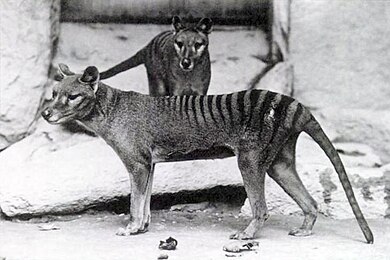Thylacine
.
The thylacine (Thylacinus cynocephalus) was the largest known carnivorous marsupial of modern times. It is commonly known as the Tasmanian tiger (because of its striped lower back) or the Tasmanian wolf (because of its canid-like appearance, traits and attributes).[14] Native to continental Australia, Tasmania, and New Guinea, it is believed to have become extinct in the 20th century because of hunters. It was the last extant member of its family, Thylacinidae; specimens of other members of the family have been found in the fossil record dating back to the late Oligocene.
Surviving evidence suggests that it was a relatively shy, nocturnal creature with the general appearance of a medium-to-large-size dog, except for its stiff tail and abdominal pouch (reminiscent of kangaroo) and dark transverse stripes that radiated from the top of its back, similar to those of a tiger. The thylacine was an apex predator, like the tigers and wolves of the Northern Hemisphere from which it obtained two of its common names. As a marsupial, it was not closely related to these placental mammals, but because of convergent evolution it displayed the same general form and adaptations. Its closest living relative is thought to be either the Tasmanian devil or the numbat. The thylacine was one of only two marsupials to have a pouch in both sexes (the other being the water opossum). The male thylacine had a pouch that acted as a protective sheath, covering his external reproductive organs while he ran through thick brush. The thylacine has been described as a formidable predator because of its ability to survive and hunt prey in extremely sparsely populated areas.[4]
The thylacine had become extremely rare or extinct on the Australian mainland before British settlement of the continent, but it survived on the island of Tasmania along with several other endemic species, including the Tasmanian devil. Intensive hunting encouraged by bounties is generally blamed for its extinction, but other contributing factors may have been disease, the introduction of dogs, and human encroachment into its habitat. Despite its official classification as extinct, sightings are still reported, though none have been conclusively proven.
Protect This World
We need to protect this world because God has given this world to us, so we need to protect it, all of it
its land, its seas and or ocean, sky, and also the animals that God has gave us.
We can hunt them but we need to becarefull when we hunt so that we don't make them extinct and just disappear from the face of our planet and you can read Genesis 1 to know about the creation of the universe.

Comments
Post a Comment